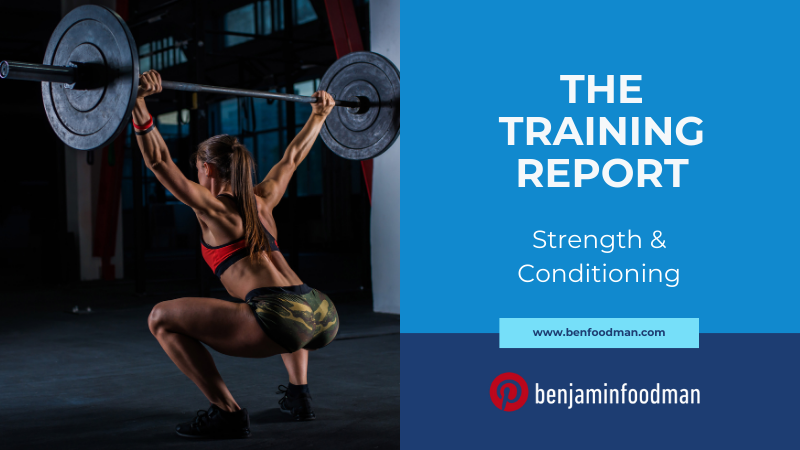Strength & Conditioning - Exercise Science Periodization Strategies Part V. Warm Up & Flexibility For Athletes
About the Author
Ben Foodman is a licensed psychotherapist & performance specialist. He owns his private practice located in Charlotte North Carolina where he specializes in working with athletes to help them overcome mental blocks (the yips), PTSD, ADD / ADHD and achieve flow states through the techniques of Brainspotting & Neurofeedback. If you are interested in services, use the link here! Enjoy the article below!
Introduction: A Quick Overview Of The Warm Up For Athletes
Many athletes will engage in warm ups during pre-game routines. However, in my conversations with athletes there is a significant number of individuals who do not place enough emphasis on being fully mentally present for warm ups. Certified Strength & Conditioning Specialists (CSCS) have a strong baseline understanding of the importance of the warm up, but have not always presented the best communication around WHY athletes need to be more motivated for this portion of their training. Because this is such an important part of an athlete’s performance, I wanted to provide some quick, introductory information on the importance of warm ups, how warm ups help improve performance, and different types of sport-related warm ups. Let’s first explore introductory information about what warm ups do for athletes.
Part I. Basic Introduction To The Warm Up & Flexibility For Athletes
When reviewing the Essentials of Strength Training and Conditioning, the authors state the following when it comes to describing the warm up: A warm up period is now almost universally accepted as an integral part of any training session or competition. Essentially, its goal is to prepare the athlete mentally and physically for exercise or competition. A well-designed warm up can confer a number of physiological responses that can potentially increase subsequent performance. These can be divided into temperature related effects and non-temperature related effects. Temperature related effects include an increase in muscle temperature, core temperature, enhanced neural function and the disruption of transient connective tissue bonds, while non-temperature related effects can include increased blood flow to muscles, an elevation of baseline oxygen consumption, and post-activation potentiation. Warm up effects are best elicited via an active type of warm up rather than via passive warming techniques.
The following examples provided are positive effects on performance that warm ups and stretching have on athlete performance outcomes:
Faster muscle contraction and relaxation of both agonist and antagonist muscles
Improvements in the rate of force development and reaction time
Improvements in muscle strength & power
Lowered viscous resistance in muscles and joints
Improved oxygen delivery due to the Bohr effect, whereby higher temperatures facilitate oxygen release from hemoglobin and myoglobin
Increased blood flow to active muscles
Enhanced metabolic reactions
An increased psychological preparedness for performance
Part II. Considerations Of Components Of A Warm Up For Athletes
Per the National Strength & Conditioning Association’s guidelines, it is ‘generally advised that a warm-up consist of a period of aerobic exercise, followed by stretching and ending with a period of activity similar to the upcoming activity. A warm up program structure is built around these requirements and typically involves two key phases’. A general warm-up period lasts about 5 minutes of very low pace aerobic exercise which includes movements such as jogging or cycling. The purpose of this portion of the warm up period is to increase heart rate, blood flow, deep muscle temperature, respiration rate, and perspiration and decrease viscosity of joint fluids. This phase is typically followed by stretching which seeks to replicate the ranges of motion require for the upcoming sport activity.
After the general warm up is the specific warm-up phase. Again, authors from the NSCA essential guide state the following: during this phase of the specific warm up, which incorporates movements similar to the movements of the athlete’s sport, should also include rehearsal of the skill to be performed. The whole warm-up should progress gradually and provide sufficient intensity to increase muscle and core temperatures without causing fatigue or reducing energy stores. Typically, it should last between 10 and 20 minutes; the shorter time periods are far more common in the majority of training sessions. Longer time periods are more common in cases in which aspects of the warm up are an integral part of the main session, or when specific competition warm up are being carried out. Now that we have reviewed warm up principles, let’s go over specific warm up exercises you can potentially use in your regimin.
Part III. Sample Warm Up Drills
Spinal Twist - Muscles Affected : internal oblique, external oblique, piriformis, erector spinae
Supine Knee flex - Muscles Affected: hip extensors (gluteus maximus and hamstrings)
Side Bend With Bent Arm - Muscles Affected: external oblique, latissimus dorsi, serratus anterior, triceps brachii
Sitting Toe Touch - Muscles Affected: hamstrings, erector spinae, gastrocnemius
Note To Reader:
If you are an athlete reading this segment of the TRAINING REPORT, hopefully this content was helpful! I put the Training Report together because I felt like many of the discussions on issues such as the Yips/mental blocks, strength training & other subject matter on athlete performance concepts were really missing the mark on these ideas (e.g. how trauma is the direct cause of the Yips). If you are interested in learning more, make sure to subscribe below for when I put out new content on issues related to sport psychology & athlete performance! Also, if you are looking to work with a mental performance specialist, you are in the right place! USE THIS LINK to reach out to me to see if my services are the right fit for your goals!
ARE YOU ON THE LIST?
Make sure you’re signed up to Ben’s mailing list to receive news & updates on new strategies in sport psychology, upcoming workshops & products. Don’t wait, sign up now!


























